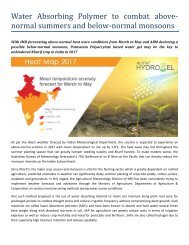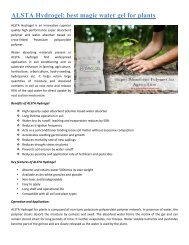Alsta Hydrogel Super Absorbent Polymer - Hydrogel Agriculture
Hydrogel Polymer marketed by Chemtex Speciality Limited under the name Alsta Hydrogel is a water retaining agent with the capacity of holding up to 400 – 600 times water than its own weight. Hydrogel agriculture or the use of super absorbent polymer for agriculture refers to hydrogel polymer application in soils for the purpose of stably providing water to the plants irrespective of drought and dry seasons. The plants can absorb water from this nontoxic water absorbent polymer throughout. Hydrogel in Agriculture is a potassium based super absorbent polymer acting in drought prone areas and rain-fed agriculture as a water retaining agent.
Hydrogel Polymer marketed by Chemtex Speciality Limited under the name Alsta Hydrogel is a water retaining agent with the capacity of holding up to 400 – 600 times water than its own weight. Hydrogel agriculture or the use of super absorbent polymer for agriculture refers to hydrogel polymer application in soils for the purpose of stably providing water to the plants irrespective of drought and dry seasons. The plants can absorb water from this nontoxic water absorbent polymer throughout. Hydrogel in Agriculture is a potassium based super absorbent polymer acting in drought prone areas and rain-fed agriculture as a water retaining agent.
You also want an ePaper? Increase the reach of your titles
YUMPU automatically turns print PDFs into web optimized ePapers that Google loves.
2. <strong>Super</strong> <strong>Absorbent</strong> <strong>Polymer</strong>s (SAPs)<br />
Extensive research all over the world, particularly Iran, China, Europe and USA has led to the development of a particular<br />
class of <strong>Super</strong> <strong>Absorbent</strong> <strong>Polymer</strong>s that can increase water use efficiency and enhance crop yield. Soil conditioning with<br />
SAP is an interesting and innovative facet in the field of modern agriculture as well as rainfed agriculture. It was shown<br />
that SAP materials are hydrophilic networks that can absorb and retain large amounts of water or aqueous solutions. Their<br />
uptake can be as high as 100,000% and even more. SAPs are in general, small sugar like hygroscopic crystals that can be<br />
directly added to cultivation soils. They are predominantly used for improving irrigation efficiency; smart delivery<br />
materials that can help combat plant pathogens even with lower pesticide dosage, reducing the quantity of soluble NPK<br />
fertilizers per crop cycle thus greatly contributing to water and environmental conservancy practices.<br />
2.1. <strong>Hydrogel</strong>s<br />
<strong>Hydrogel</strong> agriculture technology involves gel forming polymers that are insoluble water absorbing polymers designed<br />
exclusively for agricultural use by the late 1980’s. They were developed to improve physical properties of soil to:<br />
a) Increase water holding capacity<br />
b) Increase water use efficiency<br />
c) Enhance soil permeability and infiltration rate<br />
d) Reduce irrigation frequency<br />
e) Reduce compaction tendency<br />
f) Stop soil erosion, farm run-off & surface leaching<br />
g) Increase plant performance, particularly in structure-less soils stressed with drought condition<br />
<strong>Hydrogel</strong>s as they are commonly called are cross-linked three-dimensional networked water absorbent polymers. Three<br />
main types of <strong>Hydrogel</strong>s have so far been found appropriate for agricultural use:<br />
i. Starch-graft copolymers<br />
ii. Cross-linked Polyacrylates<br />
iii. Cross-linked Polyacrylamides & Acrylamide-acrylate copolymers<br />
Potassium Polyacrylate is the principle material used in SAP industry and marketed as hydrogel for agricultural use<br />
because of its longer retention and high efficiency in soil with nil toxicity issues. They are prepared by polymerizing<br />
Acrylic acid with a cross linker. Cross-linked polymers can hold water 400 times their own weight and release 95% of that<br />
to growing plants. Use of <strong>Hydrogel</strong> leads to increased water use efficiency by preventing leaching and increasing<br />
frequency for irrigation. During summer months particularly in semi arid regions, lack of soil moisture can cause plant<br />
stress. Moisture released by hydrogel close to root area helps reduce stress and increase growth and plant performance.<br />
<strong>Hydrogel</strong>s can reduce fertilizer leaching and reduce application of pesticides.<br />
2.2. Water Absorption with <strong>Hydrogel</strong><br />
<strong>Hydrogel</strong> works as water reservoirs round the root mass zones of<br />
the plant. In presence of water, it expands to around 200-800 times<br />
the original volume. There is ample possibility to trap irrigation and<br />
rainwater that can then be collected, stored and gradually released<br />
for crop requirements over prolonged durations. <strong>Hydrogel</strong> mixed<br />
with soil increase soil permeability and improve germination rates.<br />
It is compatible with a wide range and type of soils and thus has in<br />
general a tendency to increase plant performance and yield.<br />
Rainwater retention, soil erosion by storm water run-offs, especially in sloped terrains can be greatly averted. There has<br />
been proof of decrease in fruit & vegetable loss due to insect by around 10-30%.






